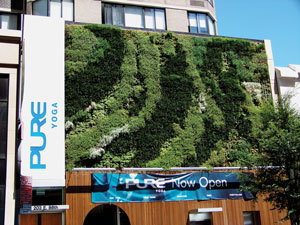1/15/2009
Getting Vertical
Pam Buddy-D’Ambrosio

Whether you desire vegetation as decoration, advertisement, food or energy savings, you can take an upright approach, thanks to French botanist and green wall advocate Patrick Blanc.
A decade ago, George Irwin, CEO and president of Green Living Technologies (GLT) in Rochester, New York, a green wall specialist, researched German green roof installation standards. George then partnered with Diane DeGregorio, and today GLT’s walls can be seen throughout the world—at Pure Yoga in New York City; the Anthropologie store in Huntsville, Alabama; and in Los Angeles as part of the Urban Farming Food Chain.
Greg Garner, president of Elevated Landscape Technologies (ELT) in Brantford, Canada, says his company and its certified agents have installed approximately thirty green walls in North and South America, Asia and Europe.
Energy conservation isn’t the only benefit from green walls. The systems provide storm water management, sound barriers, natural aesthetics and a “green” image, says Greg. In addition to marketing opportunities—George says GLT creates logos, hanging bracket systems that float in front of a façade and leased freestanding walls for corporate events and weddings—the plants beautify the area, add humidity and rid the air of volatile organic compounds.
Both GLT and ELT use succulents, grasses, evergreens and edible crops in their exterior and interior walls. The most popular plants for the indoor ELT green walls in Canada and the United States are dracaena, prayer plant and croton.
Installation of the planted panels involves a bracket system with irrigation as a row-by-row drip line or manually filled drip pans. A green wall can cost “around $100 per square foot, but can be as high as $200, depending on the plant list,” says Greg. For GLT, George says, “The biggest challenge here in the U.S. is today’s economy.” Costs can be reduced, he adds, if the client gives six months lead time, allowing the use of smaller plants that can mature in the walls in the growing facility. A quicker installation uses mature plants at a 20 to 25% price increase.
Steven Peck is founder and president of Green Roofs for Healthy Cities in Toronto, Canada, a not-for-profit association that offers green wall installation training. Within the last year, 300 professional designers have taken the course, says Steven.
“My goal is to help the building industry evolve toward healthy and restorative buildings, which give back more than they take over their life cycles.”
Pam Buddy-D’Ambrosio is a freelance writer based in New Rochelle, New York.